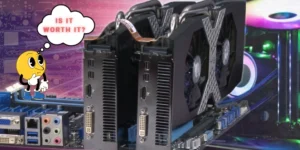What’s the difference between NVIDIA’s GTX and RTX graphics cards? RTX cards are newer and use more advanced technology, resulting in much better performance. GTX cards are older now, and while NVIDIA is still making them in small amounts, they are no longer the main focus, and the company may transition entirely to RTX in the next few years.

NVIDIA GeForce GTX vs RTX
Both NVIDIA GeForce GTX and RTX utilize the NVIDIA Turing architecture to give outstanding performance with minimal power usage. However, there is a fundamental difference that only RTX cards have RT and Tensor Cores. In which RT Cores are specialized ray tracing hardware used to create real-time shadows, reflections, and refractions. Additionally, Tensor Cores using Deep Learning Super Sampling (DLSS) technology to speed up final image rendering while preserving frame rates and enhancing resolution.
Here’s what else you should know about the difference between GTX and RTX graphics cards.
What Are GTX Cards?
GTX, or Giga Texel Shader eXtreme, is the previous main series of graphics cards at NVIDIA, following the shorter-lived GT and GTS series. In this context, a Texel is an individual component of a texture map, which is needed to create textures and visuals on a computer screen.
A Gigatexel, spelled without a space unless it is the graphics card name, equals one billion Texels per second. NVIDIA started using this name around the point where they broke through this limit to indicate the overall performance and quality of their graphics cards.
While a Gigatexel sounds like a lot, NVIDIA hit this point back in 2005 and is not very impressive compared to the performance of modern graphics cards. Imagine a car manufacturer saying you could go 0 to 30 miles per hour in ten seconds in their car. While true, it is not enough performance to matter to most people.
What Are RTX Cards?
RTX stands for Ray Tracing Texel eXtreme and is the latest generation of technology for NVIDIA graphics cards. They have two primary components that separate them from older, less-impressive technology.
The first component, and the source of the name, is the RT cores. These let the graphics card do real-time ray tracing, which is fundamentally an advanced lighting technique that makes things look significantly more realistic. Ray tracing requires calculating every bit of light from each source, so it took a lot of processing power to pull off.
Here, it is worth noting that few games use ray tracing to its full potential. Ray tracing in games will probably become more common over the next few years as more people upgrade to RTX cards, but at the moment, it’s mainly a gimmick.
The other feature that separates RTX cards from their predecessors is the inclusion of tensor cores. Tensor cores support high-performance computing operations, AI activities, and deep learning. With the correct coding, the cards are capable of significantly higher performance.
Most RTX cards are powerful enough to satisfy gamers (and many professionals) for all but the most intensive tasks. People who need particularly high-end performance will still want to buy the latest and greatest cards as they come out. However, a thoroughly standard RTX card remains sufficient that practically any game will look amazing as long as your other parts are decent.
Difference Between GTX and RTX
The short and easy answer is that RTX is fundamentally better than GTX. However, while we know that RTX is better, it is worth looking at some numbers to see how much better they are. Graphics cards change often enough that no comparison is perfect forever, but we can look at a few notable releases.
Changes In Price vs Performance
The NVIDIA Titan X, released in early 2015, was one of the final main GTX graphics cards they developed and a significant improvement over earlier cards in their line. As UserBenchmark reports, the Titan X could produce about 118 frames per second for reflections and 115 frames per second for parallax details. It sold for over $1000.
For its time, this was quite a respectable card.
The RTX 3060-Ti is not a top-end graphics card for gamers. It is more of a standard gaming card, offering great value and performance for the price. Released in late 2020, the 3060-Ti has about 176 frames per second for reflections and parallax of over 184 frames per second.
On purely technical merits, the RTX 3060-Ti is about 70% better than the GTX Titan X and well under half the price if you can find it in stock anywhere. Given that these are not the extremes, the GTX Titan X is an excellent card versus a mid-range RTX choice. The high-end RTX cards are, of course, even more impressive in comparison.
SLI GTX vs RTX
RELATED: What Is SLI? Is SLI Worth It? A Guide For Multi-GPU Technology
SLI (Scalable Link Interface) is the multi-GPU technology of NVIDIA to enable two or more identical GPUs to collaborate for double or greater performance. For low-performance GTX, it makes sense to take advantage of SLI. You can get better graphics performance at a lower cost.
As of today RTX is a huge step forward in terms of performance. So, SLI of RTX graphics cards is not a good option. Especially since SLI is no longer supported by many games.
However, the decision is entirely yours. With RTX SLI, you not only get the thrill of high-performance graphics, but you also get to own cutting-edge hardware that no one else has.
Electricity Use
One lesser obvious detail is electricity use for graphics cards. RTX systems use significantly less electricity for the same performance as prior generations of graphics cards, which is not a minor consideration given how many people are using computers these days.
State and federal agencies are starting to look at computers’ electricity use as a serious issue, going so far as to ban computers from some manufacturers in certain areas because they require too much energy. The California Energy Commission (CEC) Tier 2 is a good example of a state agency restricting overpowered computers in California.
On multiple levels, anything reducing electricity use is fundamentally good for manufacturers and consumers alike. What makes the latest graphics cards so impressive is their ability to offer significantly better performance at much lower electricity costs.
Deep Learning Super Sampling
Deep Learning Super Sampling (DLSS) is a relatively new technology that uses AI to upscale lower-resolution images. Upscaling lower-resolution textures can produce results similar to or even better than high-resolution images but with a much lower performance requirement.
Performance is king for using graphics cards effectively. Anything that reduces the load on the graphics card helps increase the smoothness and overall performance. Unfortunately, DLSS needs to be programmed per game, but it is an extraordinarily powerful alternative that other manufacturers, like AMD, cannot quite match yet.
DLSS is exclusive to NVIDIA RTX cards right now. GTX cards physically cannot do things like this, so it is one more layer where RTX is the clear winner.
Final Thoughts
GTX was the preferred technology for graphics cards for a long time, but RTX is a huge leap over prior performance. This isn’t just slightly better rendering or a few more frames per second, this is a substantial leap forward.
RTX cards offer significantly higher performance, lower power consumption, and unique technologies compared to GTX. As if that wasn’t enough, they are also consumer-friendly, with lower-end RTX cards available in a realistic $400 range.
If you’re ready to upgrade your PC and trying to decide between the options, save yourself a lot of trouble and buy an RTX card.





